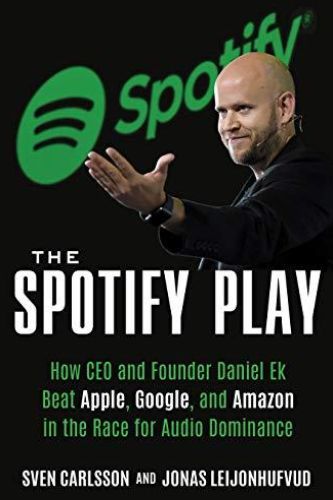Swedish tech journalists Sven Carlsson and Jonas Leijonhufvud tell the warts-and-all saga of Spotify’s long hard climb from a tech entrepreneurs’ fantasy to a $35 billion valuation.

Streaming Money
Spotify rose to prominence despite long odds, as Swedish tech journalists Sven Carlsson and Jonas Leijonhufvud explain in telling the company’s saga. Only through dogged perseverance did the scrappy firm – which lets users listen to music for free – convince the giants of the music industry to grant it song licenses. And only through stubbornness did Spotify’s CEO Daniel Ek stiff-arm increasingly lucrative buyout offers from Microsoft, Google and Tencent. The details of Ek’s ceaseless efforts are both exhausting and inspiring.
Two Swedish Entrepreneurs
Martin Lorentzon and Daniel Ek were ambitious techies. Ek, who became the face of Spotify, loved technology and music, where Napster shaped his tastes and his view of the internet.
Spotify was like a foreign vermin threatening to invade Apple’s walled garden.Sven Carlsson and Jonas Leijonhufvud
In his early 20s, Ek sold an advertising tech company for $1 million. He conceived of Spotify as a torrent-based streaming service that would provide music and possibly video to users for free, funded by advertising. He worked with Lorentzon, who was older and more experienced.
Spotify’s initial songs came from The Pirate Bay, a website on which users shared music they copied and uploaded illegally.
Apple’s iTunes Music
Spotify launched three years after Steve Jobs unveiled the concept of iTunes. When iPhones arrived, Spotify was available only on desktops. Record labels rejected Spotify’s proposal to let users listen for free and to pay for rights by sharing ad revenue.To the music industry, free streaming equaled theft.
Daniel Ek was now acutely aware that Spotify’s money was running out.Sven Carlsson and Jonas Leijonhufvud
Ek loaned tens of thousands of dollars of his personal funds to Spotify, which launched in 2008 with record company deals that allowed it to stream music in Scandinavia and other corners of Northern Europe. A $12 million fundraising round set Spotify’s value at $86 million.
Precarious Financial Model
Spotify promised 55% of its revenues to record companies and 15% to music publishers who represented songwriters. In theory, Spotify could keep the remaining 30%. But for years, Spotify paid more to the music industry than it generated in revenues. The company expected that paying customers would become only a fraction of its subscribers. The rest – up to 98% of listeners – would use the free version that featured ad sales.
If enough big names boycotted Spotify, the service could quickly become irrelevant.Sven Carlsson and Jonas Leijonhufvud
In 2009, Spotify launched a mobile version, but it had no US agreement for the rights to songs and no presence in Apple’s App Store.
Sketchy Investors
As Spotify tried to expand in the United States, Apple dangled a much more lucrative deal to music publishers than Spotify could offer.
Spotify’s business model relied on volume.Sven Carlsson and Jonas Leijonhufvud
In 2010, Spotify reached five million users, though it was still losing money. Spotify raised $50 million in 2010, but its new investors included Russian oligarch Alisher Usmanov, famous for his cozy relationship with Vladimir Putin, and Tencent, which operated under the thumb of the Chinese government.
Tough Negotiations
In certain regions, Spotify limited free users to 20 hours of music a month and allowed only five repeat plays of any song. Apple urged music companies not to allow Spotify into the US market.
Daniel Ek’s partnership with Facebook brought seven million new listeners to Spotify within a few months.Sven Carlsson and Jonas Leijonhufvud
Spotify signed a deal in 2011 to stream Sony Music content in the United States, and Sony received a big stake in Spotify. Universal would demand 10% of Spotify’s shares for access to its American market, but Spotify negotiated a less-onerous deal.
Mark Zuckerberg wanted to make Facebook the only place where users could have access to their Spotify accounts. Facebook raised Spotify’s profile, but users weren’t happy that their Facebook friends could see their musical choices.
Pandora and Google
Pandora had 36 million users and a larger valuation than Spotify, which needed to launch a radio station to play related selections for users who played one song.
To fulfill his promise to investors of large-scale success in the United States, Daniel Ek needed to offer more than a searchable music database. Sven Carlsson and Jonas Leijonhufvud
Ek considered a buyout offer from Google, but he wanted at least $8 billion; Google stalled at $5 billion.
Growing Pains
By 2014, Spotify grew by 50%, but most of its new subscribers didn’t pay. Spotify was losing money because more than 80% of its revenues went to record companies and songwriters.
Spotify’s free tier had become something of a liability.Sven Carlosson and Jonas Leijonhufvud
By 2016, streaming was the biggest source of revenue for the US music industry. Ek felt loyalty to Sweden, but chafed at its steep taxes on stock options. He shifted the company’s growth to New York City, where Spotify received $11 million in rent reductions for creating 1,000 jobs.
Artists
In 2016, Beyoncé, Rihanna, Drake, Kanye West and Frank Ocean released blockbuster albums. None were available on Spotify. Then, in 2017, Spotify struck a deal with Universal, limiting Spotify’s paying subscribers to only two weeks of access to new music from Drake and Taylor Swift.
The sheer magnitude of Spotify’s operation belied its CEO’s humble talk during interviews.Sven Carlsson and Jonas Leijonhufvud
Meanwhile, Spotify and Tencent agreed to swap shares, and Tencent relieved Spotify of some debt.
In 2017, Spotify pioneered direct public offerings, which let Spotify bypass investment banks and sell shares directly to investors, meaning there was no publicly stated price range for Spotify shares. The company went public in 2018, and its opening price of $165.90 a share set Spotify’s value at nearly $30 billion. The US record labels made out well in the IPO – their shares were worth $3 billion.
In the Black
In May 2020, Spotify paid more than $100 million for The Joe Rogan Experience, a podcast with a huge fan base on YouTube.
Fourteen years after its founding, Spotify was still wrestling with a business built on low margins, and investors were still asking how Daniel might bring them up further. Sven Carlsson and Jonas Leijonhufvud
Investors pushed Spotify’s valuation past $35 billion as the company edged toward profitability. Spotify reported four quarters in the black during its first two years of public trading.
Review
Given their irreverent, bemused attitude, Sven Carlsson and Jonas Leijonhufvud clearly enjoy reporting the saga of Martin Lorentzon and Daniel Ek. Especially Ek. His combination of shambling, relentless hustle and willingness to goad the biggest entertainment companies in the world make him the authors’ hero, and quite likely yours as well. The authors have a rollicking good time without losing sight of the cold, cunning business that brought Lorentzon and Ek their fortune. Carlsson and Leijonhufvud seem especially impressed that Ek turned down billions in search of more billions. A fun, eye-opening read.
Works on similar themes include Create the Future by Jeremy Gutsche; Zucked by Roger McNamee; and The Four by Scott Galloway.






